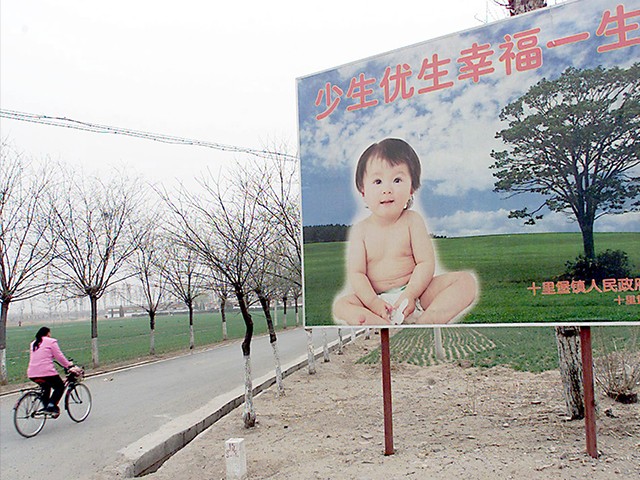Demographic decline was a big story around the world in 2023, as most industrialized nations wrestled with lower fertility rates while countries like South Korea and China slid into population crises.
Each crisis had unique cultural and historic factors, such as the lingering hangover from China’s brutal One Child Policy of forced abortions and sterilization, but no one seemed able to crack the code of maintaining population growth alongside industrial development.
This was especially vexing for China, whose authoritarian rulers assumed they could order their subjects to have more babies as easily as they once forced them to stop multiplying. China kicked off the year by admitting to its first population decline since Chairman Mao’s mass murder spree in the 1960s, the “Great Leap Forward.”
By the halfway point of the year, Chinese officials were frantically trying to shame people into having babies by calling them “pedophobes” if they refused. In August, the city of Xian sent out text messages on the Chinese version of Valentine’s Day urging residents to think about “sweet love, marriage, and childbirth.”

A woman cycles past a billboard encouraging couples to have only one child, along a road leading to a village in the suburb of Beijing, 25 March 2001. China repealed the policy and has enthusiastically urged couples to have more children since 2015, but birth rates have not increased. (GOH CHAI HIN/AFP/Getty Images)
The One Child Policy left China in a deep demographic hole by creating a shortage of fertile young women, since parents legally restricted to a single child generally held out for a boy. It also produced some unique social deformations, such as a tendency to spend more heavily on only children that created unrealistic expectations when the One Child Policy was lifted.
The worst fertility crisis in the world, however, is presently afflicting South Korea – a population collapse so swift and severe that pediatric clinics and kindergartens are shutting down.
South Korea could lose nearly half its population by the end of the century if current birth rates continue. South Korean society is almost growing allergic to children, as if they were weird alien things that childless people should never have to encounter.
"In South Korea, child-free zones are increasingly popular, but parents say it's holding back the next generation"
Si ca n'arrive pas au #Japon bientot (si c'est pas déjà ds quelques endroits d'ailleurs), je me coupe la droite (la jambe) pic.twitter.com/0kT54qkL0Q— shootjapan (@ShootOsaka) December 3, 2023
Japan, which was one of the earliest cases of rapid population decline, reported in 2023 that every prefecture except one is still in decline, with some losing 30 to 50 percent of their population. The national population is projected to decline by another 17 percent over the next quarter-century.
The one prefecture in Japan that is expected to grow by 2050 is Tokyo, and its surrounding counties are declining more slowly than the rest of the country. Demographers suggested this is an understandable phenomenon in a time of population decline coupled with extended lifespans, as the growing number of elderly residents naturally flock to big cities where medical and social services are easier to access.
Population growth in the United States is, unsurprisingly, a more complicated story. A large country with very diverse demographics and a high rate of immigration does not have to worry about population decline in the near term, although the Census Bureau projects the American population could begin flattening out by the end of the century and some groups within the American populace have higher fertility rates than others.
Still, the Census Bureau sees “an excess of deaths relative to births” in all of its scenarios for the future, probably beginning sometime in the next three decades. Fewer births and longer lifespans mean the American population is aging, but not yet vanishing like in South Korea.
The essential challenge facing the industrialized world is simple enough: the high cost of raising children makes couples worried about sacrificing their lifestyles and career ambitions to bring up large families, which are simply indispensable to population growth.
The cost of raising children is not simply the raw cost of their health care and material needs, which is why China’s efforts to nourish birthrates with childcare incentives have not worked as well as planners anticipated. The total cost includes an opportunity cost that is far more difficult to reimburse, especially for women.
As women grow more educated and ambitious in any given society, the opportunity cost of getting married and having children increases, especially for young women with lofty career ambitions. Offering government subsidies for diapers and kindergarten does not change this calculation very much. Singapore offers some incredibly generous subsidies for child-rearing, but they have had little effect on fertility rates.

In this picture taken on May 8, 2015, a mother holds her child in the subway in Tokyo. AFP PHOTO / FRED DUFOUR (Photo credit should read FRED DUFOUR/AFP via Getty Images)
Various cultural and economic factors in specific countries are layered on top of this underlying dynamic. The declining Asian nations tend to be culturally homogenous and have very low rates of immigration, for example. China’s young generation is worried about the deteriorating economy, the tottering real-estate sector, and reduced job prospects, so they are nervous about getting a family started.
Asian cultures tend to be biased against unwed motherhood, so women who do not want to get married are not having babies, either. Russia’s population decline is influenced by high mortality rates, large numbers of abortions, and heavy emigration.
Conversely, the world’s highest fertility rates are found in Africa, where the opportunity cost for motherhood is very low, cultural forces encouraging fertility are strong, children are needed as a simple labor resource, and the cost of developing their human capital to meet that need is minimal.
There are no easy lessons for low-fertility countries to learn by studying those with high birth rates, beyond the observation that large human populations tend to respond to perceptions of cost and benefit, and even when demographic survival is on the line, overcoming those perceptions is very difficult. Every social welfare system in the world is premised on growing populations of working young people generating tax revenues to pay for the benefits of the elderly. The designers of those systems grievously underestimated how easily their demographic projections could fall apart.

COMMENTS
Please let us know if you're having issues with commenting.